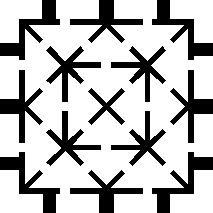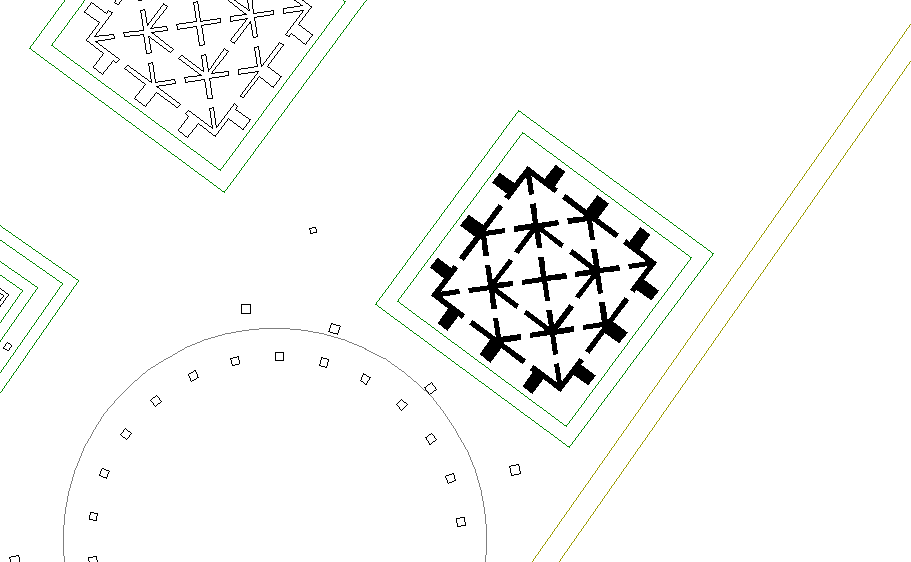new insights - key to the language of plans
1996.07.15
This note concerns my new insight into Piranesi's Campo Marzio. Eessentially I think I hit upon a substantial key concerning the language of the plans within the Campo Marzio. In retrospect, I think it was an understanding of Piranesi's plan language that I was interested in finding out from the very beginning--at least since I learned CAD.
The key to the language of plan forms starts with the long 'spiritual' axis of Mars and the tiny temple/shrine to the union of Mars and Rhea Silvia. I will not here go into the whole story of the long axis except to say that the Mars/Rhea Silvia shrine at the very end of the axis is the very basis of all the Piranesi plan forms. The plan of the shrine itself depicts, in simple planimetric form, the union of the male sex organ with the female sex organ. The plan is plain and simple, and where it not for its small size, would also be perceived as vulgar and blunt. Yet there is an essential beauty in its fertile simplicity--the notion of elementary plan forms is enhanced a thousand fold by the symbolism of outside vs. inside--gives it the power to spawn every other plan formation delineated.
The power and significance of the small shrine plan comes to the fore after an analysis of the second significant axis of the Campo Marzio--the Equiria. This axis represents the war/military aspect of Mars, and when compared with the long axis running through the altar to Mars, the Equiria, the race course, can be clearly considered the mundane axis (as opposed to the spiritual or sacred axis). The military character of the axis is quickly reinforced by the military offices and the military parade grounds that lie to the northern end of the Equiria. The fact that the Equiria is a horse race course also reinforces the mundane/military character of the axis, and this mundane aspect is most clearly manifest with the dirt road reality of the axis itself. (There may be the opportunity to call out a sacred vs. profane contrast between the two axes.)
Seeing how the first axis ends in sex, I was curious to see if the Equiria axis also ends in sex. While there is no building plan that explicitly depicts the co-joining of sexual organs, the north end of the axis has a pair of simple buildings--Vivaria Fulvii and Cochlearum Hirpini--made up of very few contiguous elements. I think this type of plan is the next step in the hierarchy after the sex temple. It is almost as if the sex temple starts something that quickly multiplies and mutates in the process. These two plans next to each other demonstrate the high order of symbolism in the first.
From the second order of plan, the next step up in the hierarchy is best exemplified by the sw Gymnasium on the Tiber and the Villa Publicus where the contiguous elements are still few yet numerously repeated, however there is a substantial addition of articulation in the individual contiguous pieces, especially in the carving out of space in the form of niches and thus heightening the issues of outside/inside, solid/void, figure/ground. This third type of plan formation is much more strongly related to the sex temple, yet the lesson of the second type of plan, the gemmation of a few parts, is a vital step in the evolutionary development of the plans. I wonder if I could here call it an embryonic development of the plan configuration. I also wonder if the second order of plan formation is to be considered profane vs. the sacred union of sex?
| |
Cochlearum Hirpini
1998.12.01
coclearium : an enclosure or pen in which snails were kept and fed
Hirpini : a people of Lower Italy, between Campania, Lucnia, and Apulia
|
Positioned at the northern-most end of the Equiria, the Cochlearum Hirpini forms a symmetrical building composition together with the Vivaria Fulvii. This pen for storing and feeding snails has no historical or archeological substantiality, nor does it play any direct role in the Equiria's general horse-race or military theme. Even the name Hirpini offers no substantial clue as to the possible reason that Piranesi placed such a building at this location.
On purely literal terms, there is a connection between the word cochlea - spiral - and the Naumachia Domitiani's spiral formation. Otherwise, Piranesi may be making some kind of "inverted" joke regarding the swiftness of the Equirian horse-races and the slowness of snails.
| |

Cochlearum Hirpini
The Cochlearum Hirpini is a unique square building composed in plan of many sucessive squares positioned either orthogonally or diagonally. It is hard to discern however, how such a plan serves as a pen for snails.
|
Equiria
1998.12.01
The only building along the Equiria that bears no programmatic or symbolic relationship to Mars or to the horse-races, is the curious Cochlearum Hirpini.
Naumachia Domitiani
1998.12.01
Piranesi's Continual Double Theaters
2001.11.26
|

